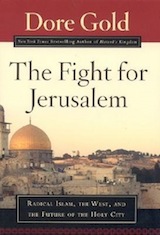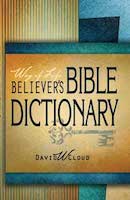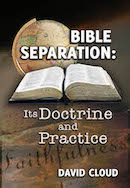866-295-4143, fbns@wayoflife.org

[This] doctrine of ‘Temple Denial’ quickly became a new Palestinian dogma that was even repeated, with the firmest conviction, by Western-educated Palestinian officials who are assiduously courted by the international media. ...
Arafat’s eventual successor, Mahmoud Abbas (Abu Mazen), also embraced Temple Denial. ... Temple Denial spread across the Middle East like wildfire from the editorial pages of al-Jazirah in Saudi Arabia to well-funded international seminars in the United Arab Emirates. It even subtly slipped into the writing of Middle East-based Western reporters. Thus Time magazine’s Romesh Ratnesar in October 2003 described the Temple Mount as a place ‘where Jews believe Solomon and Herod built the first and Second Temples.’ In three years, Arafat’s campaign had convinced a leading U.S. weekly to relate the existence of Jerusalem’s biblical temples as a debatable matter of religious belief rather than historical fact. Arafat had moved the goalposts of historical truth.
Temple Denial found fertile ground in the Arab world’s universities, particularly those with a more radical Islamist perspective, where it would affect an entirely new generation. A lecturer in modern history at Saudi Arabia’s Muhammad bin Saud Islamic University repeated a popular variation of Temple Denial in 2000, when he published a research arguing that King Solomon’s Temple was in fact a mosque. ...
The Temple Mount itself and the Western Wall attests to the Second Temple, built in the 6th century B.C. and expanded under Herod the Great in the 1st century B.C. The Western Wall contains original stones from the foundation of the Temple Mount in the days when the New Testament was written. [Benjamin Mazar, president of the Hebrew University, excavated the southern steps of the Temple Mount between 1968-78. Because of his labor, visitors today can see the actual steps upon which Jesus walked and where He preached at the main entrance to the temple area and where the Psalms of Degrees were sung.]
CLAY SEAL FROM THE FIRST TEMPLE -- [In rubble that was removed from the Temple Mount by the Palestinian-controlled Waqf and dumped in various waste sites throughout Jerusalem] Dr. Gabi Barkai found a clay seal from the Temple Mount with Hebrew writing. On the third line of the ancient seal was the name Immer, which is the last name of a man, Pashur Ben Immere, whom the Book of Jeremiah describes as an important priest in the first Temple. Looking at a set of broken lines above the name Immer, Barkai concluded that the seal belonged to a relative of Pashur named Galihu Ben Immer. The clay seal proved that a noted priestly family member at the time of ancient Israel was involved in administering the Temple Mount. ...
JOSEPHUS’ TESTIMONY -- Ancient historians from the Roman era such as Josephus have provided detailed descriptions of the Second Temple as well as the planning and execution of its destruction by Titus, the son of Roman emperor Vespasian, and his successor.
ARCH OF TITUS IN ROME -- Indeed, any tourist visiting the famous Arch of Titus in Rome can see how the Roman conquest of Jerusalem was commemorated over nineteen centuries ago with engraved images of Roman soldiers triumphantly carrying the Temple vessels, including trumpets and the seven-branched Menorah, as spoils of war.
ITEMS FROM THE TENTH ROMAN LEGION -- Throughout Jerusalem’s Old City, a variety of everyday items have been found that bear the mark of the Tenth Roman Legion--the unit that destroyed the Second Temple.
TEMPLE PLAQUES WARNING GENTILES -- Stone plaques with Greek inscriptions from the time of King Herod warning non-Jews not to enter certain areas of the Temple have also been uncovered. A complete plaque from the Temple Mount is housed in the museum in Istanbul, Turkey, and a partial plaque is housed in the Israel Museum. The plaque reads: ‘Foreigner, do not enter within the grille and the partition surrounding the Temple.’
THE TRUMPETING PLACE -- The excavation of the street level just below the Temple Mount revealed huge blocks of stone that toppled down during the Temple’s destruction, including one with a Hebrew inscription reading ‘To the Trumpeting Place.’ This corresponds with Josephus’ account of a corner of the Temple Mount where the Temple trumpet was blown to mark the beginning of the Sabbath. The eight-foot-long stone was apparently hurled down by the Roman armies from the Temple area to the pavement surrounding the Temple Mount below.
[An inscription in the Siloam Tunnel in Jerusalem celebrates the completion of a water tunnel in the time of King Hezekiah and the prophet Isaiah, described in 2 Kings 20:20. The Hebrew writing is in the early angular script used before the Babylonian exile.]
[Part of Nehemiah’s Wall has been unearthed. It matches the description in Nehemiah that the poor Jews who had returned from Babylon used whatever was at hand to rebuild the walls rather than rebuilt it with quarried stones.]
COINS FROM BAR KOCHBA REBELLION -- [Coins from the Bar Kochba revolt to liberate Jerusalem from the Roman armies from 132-135 A.D., only a few decades after the destruction of the Temple, depict the façade of the Temple with the Ark of the Covenant between the pillars.]
Throughout the twentieth century, even extremist Muslim leaders and organizations acknowledged the Temple’s existence. For example, a guide to the Temple Mount was published in 1935 by the Supreme Muslim Council, which at the time was headed by Hajj Amin al-Husseini, the notorious pro-Nazi mufti of Jerusalem. Concerning the Temple Mount (‘Haram al-Sharif’), the guide stated without equivocation that ‘Its identity with the site of Solomon’s Temple is beyond dispute.’ This mimicked the language of an earlier guidebook the council had written in 1924.
Thus the claims of Arafat and his acolytes throughout the Arab world that the Temples never existed in Jerusalem are refuted not only by the archaeological record, but also by Islam’s greatest authorities and even by Arafat’s radical predecessors.
Except for the material within the brackets, the previous is adapted from The Fight for Jerusalem: Radical Islam, the West, and the Future of the Holy City by Dore Gold (Washington, D.C.: Regnery Publishing, 2007).
CONCLUDING NOTE FROM BROTHER CLOUD
There are also the temple stones that witness to the Jewish Temple. The Lord Jesus prophesied that the beautiful temple and the surrounding buildings would be destroyed and “there shall not be left one stone upon another, that shall not be thrown down” (Mark 13:2). This was fulfilled 40 years after His resurrection when the Roman army under Titus conquered the city and destroyed the temple. Some of the stones that tumbled off the mount during this epoch event have been unearthed along the Western Wall and can be seen there today.
One of these stones with the inscription “to the place of trumpeting” was discovered by Benjamin Mazar. This corresponds with Josephus’ account in his Jewish Wars of a corner of the Temple Mount where the trumpet was blown to mark the beginning and ending of the Sabbath. “And the last [tower] was erected above the roof of the Priest’s Chambers, where it was the custom for one of the priests to stand and to give notice, by the sound of a trumpet, in the afternoon of the approach, and on the following evening of the close, of every seventh day, announcing to the people the respective hours for ceasing work and for resuming their labors.”
In a house unearthed in the Old City there is a drawing of a temple menorah dating to the first century B.C. This can be seen in the WOHL Archaeological Museum.
In 2009 Dr. Eilat Mazar, world authority on Jerusalem’s ancient archaeology, discovered the ruins of what is believed to be David’s palace. She found evidence that this was David’s actual palace and that it was occupied up until the destruction of Solomon’s temple by the Babylonians (“The World of Archeology Is Rocked,” aish.com, July 6, 2009). It was here that the aforementioned Jehucal bulla was found. Eilat is the granddaughter of Benjamin Mazar, and in their last conversation before his death in 1995, they discussed the recovery of David’s palace. She holds a doctorate in archaeology from Hebrew University and is the author of The Complete Guide to the Temple Mount Excavations.
In the 1990s two small silver scrolls were found in an ancient tomb on Ketef Hinnom (the shoulder of Hinnom), on the side of the Valley of Hinnom. After being unrolled by the Israel Museum, the scrolls were found to contain the priestly blessing from Numbers 6:24-26. Dating to the 7th century B.C., these are the oldest portions of Scripture in existence, predating the O.T. scrolls from the Dead Sea caves by 500 years (“Jerusalem: Silver Plaques Inscribed with the Biblical Priestly Benediction,” Archaeological Sites No. 1, Israel Ministry of Foreign Affairs, July 29, 1998, http://www.mfa.gov.il/MFA/IsraelExperience/History/pages/Archaeological%20Sites%20in%20Israel%20-%20Jerusalem%20-%20Silve.aspx April 27, 2010).
In 2008 the Jewish Temple Institute acquired a copy of the 1925 edition of the guidebook published by the Supreme Moslem Council, which states the following: “Its identity with the site of Solomon's Temple is beyond dispute. This, too, is the spot, according to universal belief, on which ‘David built there an altar unto the Lord’” (Arutz Sheva, Sept. 2, 2008).
In March 2008 the Israel Antiquities Authority announced that first the first time in the history of archaeological research of Jerusalem remains from the First Temple have been found close to the Temple Mount.
“A rich layer of finds from the latter part of the First Temple period (8th-6th centuries B.C.E.) has been discovered in archaeological rescue excavations near the Western Wall plaza. ... The Israel Antiquities Authority has been conducting the excavations for the past two years under the direction of archaeologists Shlomit Wexler-Bdoulah and Alexander Onn, in cooperation with the Western Wall Heritage Foundation. The remains of a magnificent colonnaded street from the 2nd century C.E. were uncovered; the street appears on the mosaic Madaba map, and is referred to by the name Eastern Cardo. The level of the Eastern Cardo is paved with large heavy limestone pavers that were set directly atop the layer that dates to the end of the First Temple period. This Roman road thus ‘seals’ beneath it the finds from the First Temple period, protecting them from being plundered in later periods. The walls of the buildings found in the dig are preserved to a height of more than two meters” (“First Temple Building Remains Found Near Temple Mount,” Arutz Sheva, Israel National News, March 17, 2008).
In 2008 a coin from the year 66 AD, the first year of the Jewish revolt, was found in debris excavated from the Temple Mount itself. The debris was excavated illegally by the Muslims in 1999 and discarded in the Kidron Valley and elsewhere. Israeli archaeologists have been sifting through the debris, and the coin is one of their finds. The ancient half-shekel coin is inscribed with “The Holy Jerusalem” on one side. The coin has been damaged by fire, perhaps even the fire that destroyed the Second Temple in 70 AD.
In December 2011, A SEAL ASSOCIATED WITH RITUAL PURIFICATION RITES in the Second Temple was found. The seal was discovered during excavations under the Robinson’s Arch next to the Temple Mount. The seal, which is inscribed with the Aramaic words “Pure for God,” was found in soil dating to or just prior to the first century A.D. Archaeologist Eli Shukron of the Israel Antiquities Authority and Professor Ronny Reich of the University of Haifa said: “It constitutes direct archaeological evidence of the activity on the Temple Mount and the workings of the Temple during the Second Temple period” (“Seal Found in Temple Mount Excavation,” Jewish Press, Dec. 26, 2011).
THE ARCH OF TITUS
Leaving the land of Israel itself, there is powerful evidence in Rome for the Second Temple and its destruction according to Jesus’ prophecy. It was a Roman army that destroyed the Temple under the leadership of Titus, and the artifacts were transported to Rome. Titus became emperor, and in 85 A.D. a monumental arch was dedicated in commemoration of his victory over the Jews. A bas-relief inside the arch depicts the spoils from the Jerusalem Temple carried in a victory procession after Jerusalem’s fall. Clearly seen are the candlestick and the silver trumpets.
This 1900-year-old monument thus stands as a silent witness to the accuracy of Bible prophecy, as the destruction depicted on it was prophesied nearly a half century earlier by the Lord Jesus Christ in Luke 19:41-44:
“And when he was come near, he beheld the city, and wept over it, Saying, If thou hadst known, even thou, at least in this thy day, the things which belong unto thy peace! but now they are hid from thine eyes. For the days shall come upon thee, that thine enemies shall cast a trench about thee, and compass thee round, and keep thee in on every side, And shall lay thee even with the ground, and thy children within thee; and they shall not leave in thee one stone upon another; because thou knewest not the time of thy visitation.”
You can disbelieve the Bible and it’s description of Israel’s history if you wish, but you cannot honestly say there is no evidence that it is true.
- Receive these reports by email
- www.wayoflife.org
______________________
Sharing Policy: Much of our material is available for free, such as the hundreds of articles at the Way of Life web site. Other items we sell to help fund our expensive literature and foreign church planting ministries. Way of Life's content falls into two categories: sharable and non-sharable. Things that we encourage you to share include the audio sermons, O Timothy magazine, FBIS articles, and the free eVideos and free eBooks. You are welcome to make copies of these at your own expense and share them with friends and family. You may also post parts of reports and/or entire reports to websites, blogs, etc as long as you give proper credit (citation). A link to the original report is very much appreciated as the reports are frequently updated and/or expanded. Things we do not want copied and distributed are "Store" items like the Fundamental Baptist Digital Library, print editions of our books, electronic editions of the books that we sell, the videos that we sell, etc. The items have taken years to produce at enormous expense in time and money, and we use the income from sales to help fund the ministry. We trust that your Christian honesty will preserve the integrity of this policy. "For the scripture saith, Thou shalt not muzzle the ox that treadeth out the corn. And, The labourer is worthy of his reward" (1 Timothy 5:18). Questions? support@wayoflife.org
Goal:Distributed by Way of Life Literature Inc., the Fundamental Baptist Information Service is an e-mail posting for Bible-believing Christians. Established in 1974, Way of Life Literature is a fundamental Baptist preaching and publishing ministry based in Bethel Baptist Church, London, Ontario, of which Wilbert Unger is the founding Pastor. Brother Cloud lives in South Asia where he has been a church planting missionary since 1979. Our primary goal with the FBIS is to provide material to assist preachers in the edification and protection of the churches.
Offering: Offerings are welcome if you care to make one. If you have been helped and/or blessed by our material offerings can be mailed or made online with with Visa, Mastercard, Discover, or Paypal. For information see: www.wayoflife.org/about/makeanoffering.html.





